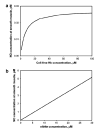Nitric oxide from nitrite reduction by hemoglobin in the plasma and erythrocytes
- PMID: 17964300
- PMCID: PMC2767202
- DOI: 10.1016/j.niox.2007.09.088
Nitric oxide from nitrite reduction by hemoglobin in the plasma and erythrocytes
Abstract
Experimental evidence has shown that nitrite anion plays a key role in one of the proposed mechanisms for hypoxic vasodilation, in which the erythrocyte acts as a NO generator and deoxygenated hemoglobin in pre-capillary arterioles reduces nitrite to NO, which contributes to vascular smooth muscle relaxation. However, because of the complex reactions among nitrite, hemoglobin, and the NO that is formed, the amount of NO delivered by this mechanism under various conditions has not been quantified experimentally. Furthermore, paracrine NO is scavenged by cell-free hemoglobin, as shown by studies of diseases characterized by extensive hemolysis (e.g., sickle cell disease) and the administration of hemoglobin-based oxygen carriers. Taking into consideration the free access of cell-free hemoglobin to the vascular wall and its ability to act as a nitrite reductase, we have now examined the hypothesis that in hypoxia this cell-free hemoglobin could serve as an additional endocrine source of NO. In this study, we constructed a multicellular model to characterize the amount of NO delivered by the reaction of nitrite with both intraerythrocytic and cell-free hemoglobin, while intentionally neglecting all other possible sources of NO in the vasculature. We also examined the roles of hemoglobin molecules in each compartment as nitrite reductases and NO scavengers using the model. Our calculations show that: (1) approximately 0.04pM NO from erythrocytes could reach the smooth muscle if free diffusion were the sole export mechanism; however, this value could rise to approximately 43pM with a membrane-associated mechanism that facilitated NO release from erythrocytes; the results also strongly depend on the erythrocyte membrane permeability to NO; (2) despite the closer proximity of cell-free hemoglobin to the smooth muscle, cell-free hemoglobin reaction with nitrite generates approximately 0.02pM of free NO that can reach the vascular wall, because of a strong self-capture effect. However, it is worth noting that this value is in the same range as erythrocytic hemoglobin-generated NO that is able to diffuse freely out of the cell, despite the tremendous difference in hemoglobin concentration in both cases (microM hemoglobin in plasma vs. mM in erythrocyte); (3) intraerythrocytic hemoglobin encapsulated by a NO-resistant membrane is the major source of NO from nitrite reduction, and cell-free hemoglobin is a significant scavenger of both paracrine and endocrine NO.
Figures







Similar articles
-
The oxidative denitrosylation mechanism and nitric oxide release from human fetal and adult hemoglobin, an experimentally based model simulation study.Blood Cells Mol Dis. 2013 Jan;50(1):8-19. doi: 10.1016/j.bcmd.2012.08.006. Epub 2012 Sep 13. Blood Cells Mol Dis. 2013. PMID: 22981699
-
Oxidation of iron-nitrosyl-hemoglobin by dehydroascorbic acid releases nitric oxide to form nitrite in human erythrocytes.Biochemistry. 2008 Mar 4;47(9):2989-96. doi: 10.1021/bi702158d. Epub 2008 Jan 29. Biochemistry. 2008. PMID: 18225862
-
Unraveling the reactions of nitric oxide, nitrite, and hemoglobin in physiology and therapeutics.Arterioscler Thromb Vasc Biol. 2006 Apr;26(4):697-705. doi: 10.1161/01.ATV.0000204350.44226.9a. Epub 2006 Jan 19. Arterioscler Thromb Vasc Biol. 2006. PMID: 16424350 Review.
-
Concerted nitric oxide formation and release from the simultaneous reactions of nitrite with deoxy- and oxyhemoglobin.J Biol Chem. 2007 Apr 27;282(17):12916-27. doi: 10.1074/jbc.M700546200. Epub 2007 Feb 23. J Biol Chem. 2007. PMID: 17322300
-
The biochemistry of nitric oxide, nitrite, and hemoglobin: role in blood flow regulation.Free Radic Biol Med. 2004 Mar 15;36(6):707-17. doi: 10.1016/j.freeradbiomed.2003.11.032. Free Radic Biol Med. 2004. PMID: 14990351 Review.
Cited by
-
Oxygen transport in the microcirculation and its regulation.Microcirculation. 2013 Feb;20(2):117-37. doi: 10.1111/micc.12017. Microcirculation. 2013. PMID: 23025284 Free PMC article. Review.
-
Nitric oxide signaling in the microcirculation.Crit Rev Biomed Eng. 2011;39(5):397-433. doi: 10.1615/critrevbiomedeng.v39.i5.40. Crit Rev Biomed Eng. 2011. PMID: 22196161 Free PMC article. Review.
-
Upregulation of cardiac NO/NOS system during short-term hypoxia and the subsequent reoxygenation period.Eur J Histochem. 2011 May 17;55(2):e17. doi: 10.4081/ejh.2011.e17. Eur J Histochem. 2011. PMID: 22193297 Free PMC article.
-
Involvement of ferryl in the reaction between nitrite and the oxy forms of globins.J Biol Inorg Chem. 2014 Oct;19(7):1233-9. doi: 10.1007/s00775-014-1181-y. Epub 2014 Jul 27. J Biol Inorg Chem. 2014. PMID: 25064750
-
cGMP modulation therapeutics for sickle cell disease.Exp Biol Med (Maywood). 2019 Feb;244(2):132-146. doi: 10.1177/1535370219827276. Epub 2019 Jan 28. Exp Biol Med (Maywood). 2019. PMID: 30691292 Free PMC article. Review.
References
-
- Singel DJ, Stamler JS. Chemical physiology of blood flow regulation by red blood cells: the role of nitric oxide and S-nitrosohemoglobin. Annu Rev Physiol. 2005;67:99–145. - PubMed
-
- Kim-Shapiro DB, Schechter AN, Gladwin MT. Unraveling the reactions of nitric oxide, nitrite, and hemoglobin in physiology and therapeutics. Arterioscler Thromb Vasc Biol. 2006;26:697–705. - PubMed
-
- Schechter AN, Gladwin MT. Hemoglobin and the paracrine and endocrine functions of nitric oxide. N Engl J Med. 2003;348:1483–1485. - PubMed
Publication types
MeSH terms
Substances
Grants and funding
LinkOut - more resources
Full Text Sources

